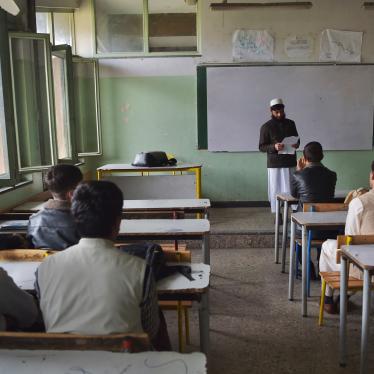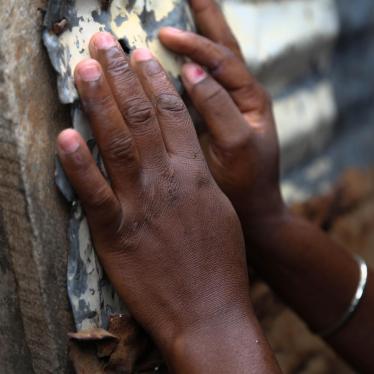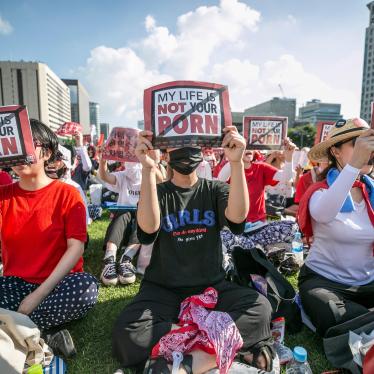Human Rights Watch appreciates the opportunity to submit information about the treatment of imprisoned women in Japan. This is in response to your Office’s call for input in preparation for a report on “the situation of human rights of women and girls in criminal justice detention, including information on practices and measures to prevent and address violence against women and girls in the context of criminal justice detention, as well as good practices and challenges relating to rehabilitation and reintegration policies and programmes.”
Human Rights Watch is an international human rights organization working in more than 100 countries around the world to document human rights violations and advocate for changes that respect and promote human rights.
The following input draws from our research on women’s prisons in Japan as well as Japan’s “hostage justice” system. Based on our research, we believe reforms are urgently needed in Japan to end the unnecessary and abusive imprisonment of women.
Background
In Japan, there are 176 penal institutions – prisons, detention centers, and juvenile prisons – under Ministry of Justice jurisdiction. Twelve of those institutions are wholly or partly designated as women’s prisons. Japan has been expanding its capacity to imprison women; as of 2022, Japan’s 12 institutions for women had the capacity to hold 6,577 people, compared to 3,441 in 2001.
After hitting a high of 5,345 women imprisoned prior to or after sentencing in 2011, the number has dropped in recent years. At the end of 2022, there were a total of 3,693 imprisoned women. In 2022, 1,554 women were newly imprisoned, which constituted 10.7 percent of people who entered prison in 2022, more than a two-fold percentage increase since 1989 when they constituted only 4.2 percent of people entering prison.
While imprisoned men go through a classification process and are housed in different prisons depending on whether they have been categorized as “developing criminal tendencies” or “not developing criminal tendencies,” imprisoned women are lumped into one category labeled, “W,” meaning they are housed with other women without any distinction based on their crimes.
For women in Japan, the leading grounds for imprisonment are convictions for theft or crimes involving drugs, such as amphetamines. In 2022, 51 percent of newly imprisoned women were convicted of theft, while 27 percent were convicted of offenses involving drugs.
Imprisonment of women for theft convictions has become increasingly common. From 1978 to 2011, convictions for crimes involving drugs were the leading causes of imprisonment among women. In 2012, theft or larceny convictions overtook drugs as the leading cause for imprisonment of women.
An increasing proportion of women entering prison are older people. In 2022, 21 percent of newly imprisoned women were 65 or older, compared to 2 percent in 1989. Most older women are imprisoned for theft. Of the 333 older women who were imprisoned in 2022, 84 percent were convicted of theft.
Mental health is also a pressing issue. The number of imprisoned women in Japan with a psychosocial disability (mental health condition) has more than doubled over the past 20 years, according to the Ministry of Justice. In 2002, the ministry identified 192 or 11 percent of women being admitted to prison as having either an “intellectual disability,” or a mental health condition. In 2022, the ministry identified 433 or 28 percent of women admitted to prison that year as having one or more psychosocial disabilities.
Women in Japan’s prisons have experienced trauma. In a survey completed in 2000 of 90 newly imprisoned women, 73 percent reported past experiences of sexual violence. A 2017 survey of 237 women also showed that more than 40 percent of women who used drugs cut themselves, 46 percent had serious suicidal thoughts, and 73 percent had been victims of domestic violence committed by their husbands or partners. The finding on domestic violence was echoed by researchers who surveyed nearly 1,000 imprisoned women at Mine Rehabilitation Program Center and Kasamatsu Prison and also found that many of the women surveyed reported that they had experienced domestic violence.
For the past two decades, recidivism among imprisoned women has been on the rise. In 2022, 48 percent of women admitted into prison had been previously imprisoned, compared to 2004 when 30 percent of women sent to prison had previous convictions. Statistics point to the difficulty women face in reintegrating into society after imprisonment; in 2022, 87 percent of the women with prior convictions who were re-admitted to prisons were unemployed at the time of their arrest.
In the pretrial phase, detainees in Japan are held at more than 1,000 police stations across the country. Women suspects are detained in some of these stations. Police investigators are also usually located at these police stations and in 2018, the United Nations Human Rights Council in its concluding observations on Japan’s Universal Periodic Review recommended abolishing this “substitute detention system” (daiyo kangoku), contending that it “increases the risk of prolonged interrogations and abusive interrogation methods with the aim of obtaining a confession.”
Abuses Against Imprisoned Women in Japan
Use of Restraints During Childbirth
Women who are pregnant while in prison are typically transported to a nearby hospital to give birth. Before 2014, authorities routinely handcuffed imprisoned women by at least one arm during labor, birth, and post-partum recovery. In 2014, then-Minister of Justice Yoko Kamikawa issued a directive to all prisons instructing them to halt using restraints on imprisoned pregnant women inside delivery rooms.
A formerly imprisoned woman told Human Rights Watch that despite Minister Kamikawa’s order, such violations happened to imprisoned women after the date of the directive. Human Rights Watch published a report in November 2023 documenting abuses against imprisoned women in Japan, including the use of restraints on imprisoned women during childbirth.
During a parliamentary session in February 2024, Japan’s then-Minister of Justice Ryuji Koizumi said that between 2014 and 2022, the Justice Ministry found six violations of the 2014 directive. In March, the Justice Ministry confirmed that it had broadened the 2014 directive to include an effective ban on handcuffing pregnant women during “transportation to outside medical institutions” and “upon arrival at the medical institution and until entering the delivery room” as “situations during which use of restraints are inappropriate.”
The Japanese government should further expand the ban by forbidding the use of restraints on pregnant prisoners during health checkups, including gynecological examinations, and immediately after giving birth, in line with the UN Standard Minimum Rules for the Treatment of Prisoners (the Mandela Rules) and expert commentary on the Bangkok Rules.
Denial of Right to Parent in Prison
As of 2019, Japan had facilities in seven penal institutions designed to permit young children to be housed there with their parents; five of these are in women’s prisons. Under article 66 of the Act on Penal Detention Facilities and the Treatment of Inmates and Detainees, children are allowed to be with their mothers inside a prison until the child is one-year-old, if the prison warden approves the mother’s request. The initial one-year period may also be extended by an additional six months, again with the warden’s approval.
In practice, however, prison authorities rarely inform mothers that they can request to keep their children with them.
Between 2011 to 2017, 184 imprisoned women in Japan gave birth. Only three were given permission to have their child with them in prison. Even for the three who received permission, the time they could stay with their babies was very limited – 12 days, 10 days, and 8 days respectively. For others, their infants were typically taken from them almost immediately after giving birth in the hospital and handed to relatives or put into institutional care. This practice is deeply harmful to both the women and their newborn babies; research has documented the importance of bonding and attachment for a newborn’s healthy mental and physical development.
Inadequate Access to Medical Services
Over the last two decades, the number of doctors working in Japan’s prisons has declined, leading to imprisoned people being denied access to quality and essential health care in a timely manner. In 2013, the Ministry of Justice determined that it needed the equivalent of 332 full-time prison doctors to provide adequate medical care for people in prison. In 2003, there were 316 prison doctors. As of April 2023, there were only 285 prison doctors.
One formerly imprisoned woman told Human Rights Watch that a fellow imprisoned woman who previously had breast cancer had requested a check-up after noticing a lump in her breast, but authorities told her to wait until her prison term was over as her release date was near. Another formerly imprisoned woman said she asked prison authorities for medication because she was diagnosed with primary ovarian dysfunction before being imprisoned, but prison authorities never provided her treatment.
Barriers to Adequate Mental Health Services
Imprisoned women in Japan who, as discussed above, have very high rates of trauma, do not have adequate access to mental health services in prison. One formerly imprisoned woman said that prison authorities denied her request to write to her therapist. Other formerly imprisoned women said the atmosphere behind prison walls is not understanding of the need for mental health services, and even when such services are available, prison authorities did not sufficiently inform imprisoned people how to access them.
Barriers to Maintaining Community Ties
Imprisoned people in Japan are allowed a limited number of visits from relatives, friends, and lawyers, but only in cases where the prison recognizes the necessity of the visit. Depending on their ranking (one to five, with one being the highest rank), which is based partly on conduct, imprisoned women can have visitors at least twice a month. Each visit is supposed to last at least 30 minutes, and visits are usually permitted only on weekdays. Visitation rooms generally have an acrylic or glass partition separating the imprisoned person from the visitor, but depending on their rank, some prisoners can have visits without partitions.
There are usually no special arrangements for children visiting their parents in prison, and parents struggle with seeing their children under difficult conditions. Visits with children conducted through a glass partition make bonding difficult. Because visits are typically available only on weekdays, children of imprisoned people and their caregivers are often forced to choose between seeing their mother and missing school. Imprisoned women can also only see their young children if someone is willing to bring their children to visit at the prison.
Bullying of Older Imprisoned Women
A woman who was imprisoned when she was in her 70s told Human Rights Watch that younger women physically abused her, while another formerly imprisoned woman described prison guards scolding older women for moving slowly.
Abuses Against Imprisoned Transgender People
Currently, all imprisoned people in Japan are housed in gendered facilities according to their legal gender registered in the government’s family registry system. However, there are many Japanese transgender people whose gender identity does not match their identity in the family registry system because of the law’s draconian, regressive, and harmful legal gender recognition requirements.
As a result, imprisoned transgender women face greater vulnerabilities to sexual violence and the government does not meet their healthcare needs.
Abuses During the Criminal Legal Process
Unnecessary and prolonged pretrial detention, abusive interrogation
Japan’s Code of Criminal Procedure allows detaining suspects for up to 23 days before indictment by a prosecutor, without empowering the judge who has imposed pre-indictment detention to provide bail. The authorities interpret the procedural code to allow interrogations throughout this period. Investigators press suspects to answer questions and confess. Even after a detainee is indicted and allowed to request bail, suspects who haven’t confessed or have remained silent often struggle to get bail approved, resulting in prolonged detention that can last months or even years.
Authorities restrict suspects from wearing bras during detention, without justification, and in many cases also during interrogations, which are typically conducted by two male investigators in a small room without legal counsel.
Prohibitions on communications with family and others during pretrial detention
Japanese law allows courts to issue a “contact prohibition order,” which puts additional pressure on suspects to confess. This order is issued routinely and restricts detained suspects from meeting and communicating with anyone other than their lawyers. Many individuals interviewed by Human Rights Watch cited this ban on communications as a cause of significant anxiety during detention.
Government Initiatives
The Japanese government has taken some steps to improve conditions within women’s prisons.
In 2013, the Ministry of Justice supported the creation of the Committee to Research and Consider How Women’s Prisons Should be Run. The committee documented major flaws in the running of women’s prisons, including lack of coordination between social welfare services and the justice system.
In 2014, the committee recommended that the Ministry of Justice improve conditions in women’s prisons by implementing reforms including improving the quality of medical care. Specifically, the initiative created a network with local medical and social welfare professionals who could undertake interventions and provide programs based on the imprisoned person’s individual characteristics such as age, health, and criminal record, and improve the workplace environment for prison staff.
To reduce recidivism, the National Diet in 2016 enacted the Act for the Prevention of Recidivism. The law requires the national government to develop and implement policies to make it easier for former offenders to reintegrate into society, including assisting them in obtaining employment and housing. Local governments are also encouraged under the law to create and promote such policies.
In 2022, the Diet revised article 12 of Japan’s Penal Code, which imposes “choeki” or imprisonment with labor, and abolished article 13 of the Penal Code, which stipulates “kinko” or imprisonment without labor. The reform created a new category of confinement called “kokin,” which directly translates into “imprisonment.” By eliminating the strict categorization of imprisonment with labor and imprisonment without labor, the Ministry of Justice aims to lower the recidivism rate by deciding on a case-by-case basis whether an imprisoned person should work, what type of work they should be doing, as well as what rehabilitation services they need. The reformed law will go into effect in 2025.
Measures in Place
The Japanese government has put in place some measures which, while not adequate at present, could be better utilized or reformed to address the ongoing abuses against imprisoned women.
Alternatives to imprisonment
Japan currently uses some alternatives to imprisonment, including monetary fines and the whole or partial suspension of prison sentences with or without probation.
Under article 25 of the Penal Code, prosecutors can suspend sentences for first-time offenders who meet specific criteria. Since 2016, judges can also partially suspend prison sentences, including for repeat offenders with a pattern of substance-related offenses.
However, when monetary fines and sentence suspensions are not an option, judges are not equipped with other forms of alternative sentencing, such as verbal warnings, community service orders, and house arrest, which are listed in the Standard Minimum Rules for Noncustodial Measures (The Tokyo Rules).
Without other options for alternative to imprisonment, Japanese judges have no choice but to send repeat offenders to prison who are not eligible for whole or partial sentence suspension.
For pretrial detainees, the Code of Criminal Procedure allows judges to provide bail only after a detainee is indicted. However, judges routinely deny bail even after indictment to those who remain silent or challenge their charges,ruling that such defendants are risks to “destroy evidence.”
Article 482 of the Code of Criminal Procedure
Article 482 of the Code of Criminal Procedure allows prosecutors to suspend a sentence based on reasons including, but not limited to, pregnancy, family responsibilities, age, and health. However, Human Rights Watch research indicates this legal provision is almost never used and it is highly unlikely that a person’s sentence will be suspended once they have been imprisoned.
For example, only 12 imprisoned women had their sentences suspended between 2019 and 2023. That figure also includes sentences suspended under article 480 of the Code of Criminal Procedure, which allows prosecutors to suspend a person’s sentence if the individual is determined to be in a “state of insanity.”
Penal Institution Visiting Committee
In 2006, when Japan replaced its nearly 100-year-old Prison Law with the updated Law Concerning the Treatment of Inmates, the new law established a Penal Institution Visiting Committee (PIVC) to provide oversight of the prison system. The PIVC consists of up to 10 people, and includes experts from the fields of law, medicine, and government.
PIVC members are responsible for monitoring conditions in penal institutions, including prisons and juvenile detention centers, through visits and interviews with inmates. The PIVC also places opinion boxes in each penal institution, allowing imprisoned people to submit comments and complaints on paper, which are conveyed to the committee. The committee has the power to make recommendations to the head of penal institutions, such as prison wardens.
However, formerly imprisoned women told Human Rights Watch that prison authorities do not adequately explain the details of the complaint mechanism to imprisoned women, and that the PIVC’s opinion boxes are not seen as useful by imprisoned women as they do not believe that they can submit complaints with confidentiality.
Avenues to justice, remedies, and reparations
Women who face abuses in prison can seek justice, remedies, and reparations in the following ways: use the complaint mechanism stipulated in articles 163 to 168 of the Act on Penal Detention Facilities and the Treatment of Inmates and Detainees, file a human rights complaint to a local Bar Association or the Justice Ministry’s Human Rights Bureau, and file a lawsuit against the government.








